Roosevelt Banks and the Attic of Doom, written by Laurie Calkhoven, illustrated by Debbie Palen; One Elm Books/Red Chair Press, 2022.
In February, Roosevelt Banks returns in an adventure in which the arrival of a sibling necessitates his move to a new bedroom in the dreaded attic of doom! Age-appropriate fun, adventure, and chills ensue, leading to a delightfully satisfying resolution. Let’s hope this is not the last we see of Roosevelt, his friends, and his family.
“There was no way I was moving into THE ATTIC OF DOOM just so a slimy new baby could take my place.”~ Roosevelt Banks, Roosevelt Banks and the Attic of Doom
Why this Book? Why will it matter to kids?
Roosevelt Banks is a likeable, relatable ten year-old whose heart is in the right place, even though he sometimes detours from his best intentions. In this second chapter book about Roosevelt, not only is he grappling with a move to the attic to make room for the arrival of his baby sister, but he is also dealing with neighborhood bullies, a rabbit mishap, and more. The Roosevelt Banks chapter books are big-hearted, funny, and pitch perfect for this age group. The characters are authentic and enjoyable, even to the “evil twins” who ultimately are treated to a satisfying comeuppance at the hand of Roosevelt.
Levels and Layers of Learning
Grade level: 2-4
Social-Emotional Learning Themes
Acceptance, compassion, concern, connection, creativity, dedication, diligence, effort, empathy, encouragement, empowerment, friendship, generosity of spirit, gratitude, helpfulness, hope, inspiration, kindness, loyalty, perseverance, persistence, perspective, resilience, resourcefulness, respect, self-assurance, self-awareness, self-management, self-reliance, tenacity, understanding
Content Area Connections English Language Arts, Community, Family, Art
Using This Book in the Classroom
Hit the Ground Running Ready Resources for Educators, Homeschoolers, and Parents
Discussion Guide for Roosevelt Banks Good-Kid-in-Training
Discussion Guide for Roosevelt Banks and the Attic of Doom
Write Away! Ideas to prompt writing
In both books, Roosevelt Banks uses writing to express himself when he is feeling big emotions. In Good-Kid-in-Training he writes a story titled “Traitors” when he is upset with his friends. In Attic of Doom he writes “a story so good, it will convince Mom and Dad that the ghosts are real and they’ll leave the attic alone.” Re-read Roosevelt’s stories. Choose a part in one of the books where Roosevelt is facing a challenge and write a story Roosevelt might compose.
Throughout Attic of Doom the “evil twins” play pranks on Roosevelt and his friends. Write your reaction to the prank Roosevelt devises at the end of the story.
Describe a place that feels spooky to you now or felt scary to you when you were younger. What did it look like? Smell like? Sound like? Feel like? What was spooky about it? What didn’t you like about it? Use as many senses as possible to describe the place. Name the place, as Roosevelt names the “Attic of Doom.”
What was the funniest part of the book? Why?
Which of Roosevelt’s friends do you like best? Least? Why? Use examples from the story to support your opinion.
At the beginning of the book, Roosevelt makes a list of fun things he’d like to do over the summer. Make your own list.
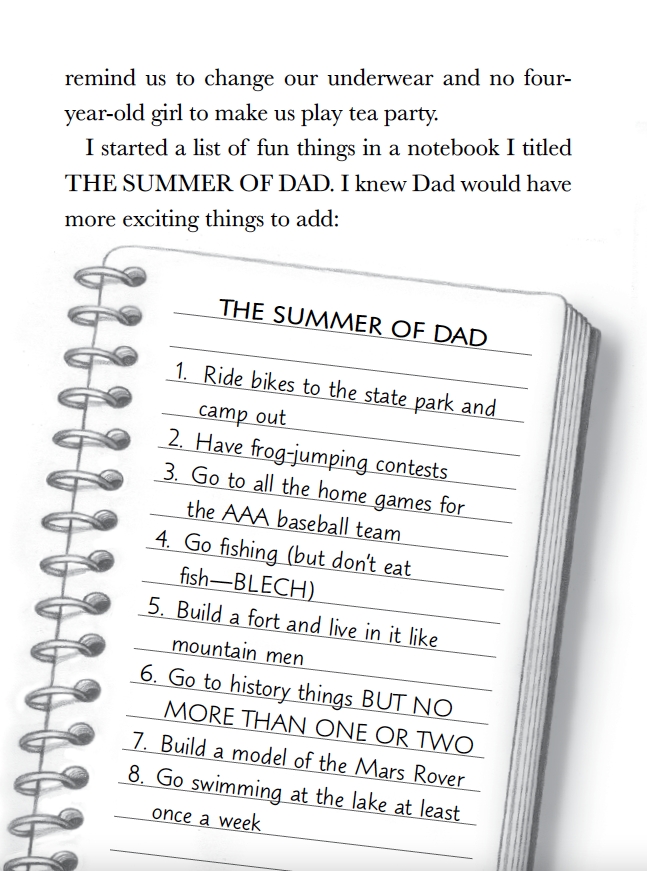
Illustration © Debbie Palen
Poetry Break Related poetry to recite before or following the reading of this book
Poetry breaks fit perfectly into brief moments in the day—from opening or closing the day to lining up for lunch; from zipping up backpacks and jackets to transitioning from one subject to the next. Reading a poem typically takes less than a minute, yet it can introduce or reinforce a concept, provide clarity, celebrate language, exemplify rhythm, enhance vocabulary, expand understanding, increase attention span, initiate reflection, spark imagination, or simply summon a giggle. And, poetry soothes and strengthens the spirit.
Below are selected poetry books and poems that pair well with the Roosevelt Banks books:
- Friends and foes: poems about us all by Douglas Florian
- If I Were in Charge of the World and other worries by Judith Viorst, illustrated by Lynne Cherry
- “The Skeleton” in Holiday Stew by Jenny whitehead
- “November Night” by Adelaide Crapsey in Firefly July: A Year of Very Short Poems, selected by Paul B. Janeczko, illustrated by Melissa Sweet
Illustration © Debbie Palen
And Then There’s This…
Enrichment activities, related books, online resources, craft projects, and ideas for further study
Draw a series of three pictures as you imagine the Attic of Doom: one from the beginning, the middle, and the end of the story. Next, draw a picture of what’s happening three months after the story ends.
Complete a character sketch graph of Roosevelt and his friends. List personality traits, interests, weaknesses, physical characteristics, and their qualities as a friend. Add details mentioned in the book, such as favorite foods or the character’s family members.
Related Books of Interest
Following is a list of recommended chapter books for 7-10 year-olds:
- Alvin Ho series by Lenore Look, illustrated by LeUyen Pham
- Bug Blonsky and His Swamp Scout Survival Guide by E. S. Redmond
- The Cayuga Island Kids series by Judy Bradbury, illustrated by Gabriella Vagnoli
- Clementine series by Sara Pennypacker, illustrated by Marla Frazee
- The Dog Who Lost His Bark by Eoin Colfer, illustrated by P. J. Lynch
- Fort Builders series by Dee Romito, illustrated by Marta Kissi
- Jada Jones series by Kelly Starling Lyons illustrated by Nneka Myers, Vanessa Brantley-Newton
- Jasmine Green Rescues series by Helen Peters, illustrated by Ellie Snowdon
- Jigsaw Jones Mystery series by James Preller, illustrated by R. W. Alley
- Judy Moody series by Megan McDonald, illustrated by Peter H. Reynolds (See also Stink series)
- Mae and June and the Wonder Wheel by Charise Mericle Harper, illustrated by Ashley Spires
- McTavish Takes the Cake by Meg Rosoff
- The Magic Treehouse series by Mary Pope Osborne, illustrated by Sal Murdocca
- Sam the Man series by Frances O’Roark Dowell, illustrated by Amy June Bates
- Sherlock Sam series by A. J. Low, illustrated by Andrew Tan
- Sydney & Taylor series by Jacqueline Davies, illustrated by Deborah Hocking
- Tales from Deckawoo Drive series by Kate DiCamillo, illustrated by Chris Van Dusen
- Twitch the Squirrel books by Vivian Vande Velde, illustrated by Steve Björkman
- Weekends with Max and His Dad by Linda Urban, illustrated by Katie Kath
- Zoey & Sassafras books by Asia Citro, illustrated by Marion Lindsey
Meet the Author

Laurie Calkhoven has never swallowed a frog, knocked over a rabbit hutch, or sung too loud in music class like her character Roosevelt Banks, but she is the author of more than 50 books for young readers, including the G.I. Dogs series and You Should Meet Misty Copeland.
Backstory: Q & A with Laurie Calkhoven
Laurie and I met a few years ago when we both participated in the Rochester Children’s Book Festival, but it was at the 2021 RCBF when we both were part of a panel on writing chapter book series titled “Get Hooked on Chapter Books: Mysteries, Non-Fiction, and Humor” that I got to know Laurie better. When I read the Roosevelt Banks books in preparation for the panel discussion, I knew I wanted to feature Laurie on the Children’s Book Corner blog.
Judy Bradbury: How did you come to write the Roosevelt Banks series? What seeded its creation?
Laurie Calkhoven: Roosevelt Banks grew out of a school visit! I talked about why we need conflict in stories with a small group of fifth-grade writers. One example I came up with was that if we read about a character who wants a bike for his birthday and then gets one, that’s very nice. It’s not very exciting to read about, however. Instead, what if the character had to earn the money for his own bike? Or had to be good for a certain amount of time for the bike to be his? What if someone else is trying to get in between him and his wish? That would be a more exciting story.
JB: How did you land on the plot for Good-Kid-in-Training?
LC: On the plane on the way home after that school visit, I started to think about that bicycle again, both to wonder why the bicycle was so important and what the character would have to do to get it. Then the name Roosevelt popped into my head and a character was born.
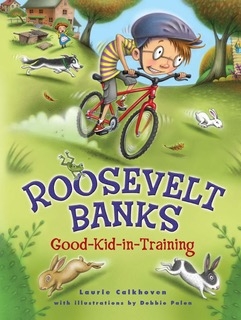
JB: At what point (and how) did you conceive of the plot for Book 2, Roosevelt Banks and the Attic of Doom?
LC: While I was writing Good-Kid-in-Training I thought Roosevelt might have more stories inside him, so I came up with a list of titles. My publisher didn’t want to commit to a second book until after the first was published, but he asked for another story about a year later. The title Attic of Doom was my favorite on that list, and I had to come up with a story to go along with it.
JB: Tell about one hurdle you experienced in the creation of the Roosevelt Banks series or provide a memorable (or humorous!) anecdote related to the writing of one of the books.
LC: I had an attic bedroom just like Roosevelt’s. When my family first moved into the house, I was convinced there were ghosts. It turned out to be a family of mice living in the walls!
JB: You are not new to writing series for children. What did you learn from writing the Roosevelt Banks books?
LC: I’ve written many series for children, but they’ve been about different characters from book to book. I had to learn how to bring a group of characters from one book to the next, to make sure they showed up on the page in the same way. I also wanted kids to be able to read Attic of Doom without having read the first book (and vice versa).
JB: What would surprise readers to learn about you or about the writing of the Roosevelt Banks series?
LC: I’ve never met or talked to the artist, Debbie Palen, but when I saw her illustrations of the characters, especially Eddie Spaghetti, I thought she must have walked around in my imagination. They look just like I imagined them.
JB: Yes! I had the same experience you describe. When I saw the first sketches Gabriel Vagnoli, the illustrator of the Cayuga Island Kids, completed of the five characters who are the “kids” in the series, I felt as if she had read my mind. I knew she was going to be great to work with, and she was!
Roosevelt Banks is one decent kid with a bit of mischief mixed in. He’s likeable and has heart, though he’s not always wise in making decisions. This makes him immediately relatable and totally believable. You’ve nailed the ten year-old! How did you develop his character?
LC: Most of my characters grow out of my memories of what it was like to be young, kids I knew growing up, and the kids in my life now. The world has changed a lot since I was ten, but people are still the same at heart—with the same wants, needs, fears, and feelings.
JB: The theme in the first Roosevelt Banks book, Good-Kid-in-Training centers on what it means to be a good friend, and how sometimes what we want—and how we pursue it—may not be in the best interest of our friend. Tell us more about that.
LC: Childhood is all about family and friends. It can be hard to maintain friendships, especially as children move into middle school. Roosevelt and his friends aren’t there yet, but they’re still dealing with challenges. It can be especially hard to watch a friend get or have what we ourselves desperately want. Being happy for them is a struggle. Roosevelt has to navigate his way through that jealousy.
JB: The second book, Roosevelt Banks and the Attic of Doom, finds Roosevelt dealing with the pending arrival of a sibling, which means he is moving to a new bedroom—in the attic!!—and “evil twins” who prank and bully him and his friends. How Roosevelt handles myriad conflicts throughout the story offers readers much to reflect on concerning problem-solving and matters of character. What do you hope readers will take away from this book and the Roosevelt Banks books as a whole?
LC: Roosevelt’s dealing with a lot of potentially scary things in this novel. Bears! Ghosts! Stink bombs! Dirty diapers! Evil twins! But he finds a way to stand up and be brave in the face of those challenges with the help of his friends. I want my readers to know that they have that inside them, too—the capacity to be brave.
JB: How do you see the Roosevelt Banks books connecting to curriculum or being used in schools?
LC: I’ve written lots of books that connect to curriculum, but the Roosevelt stories are meant to be pure FUN.
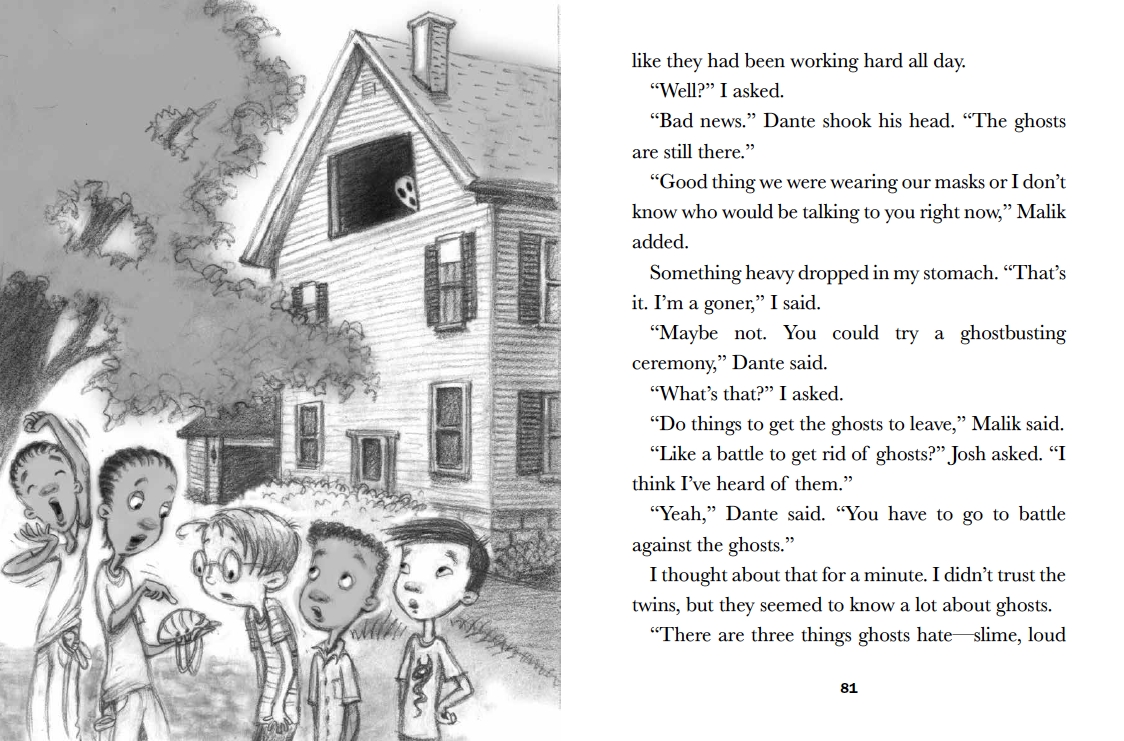
Illustration © Debbie Palen
JB: What’s next? What project are you currently working on?
LC: I just finished a historical novel set in New York City about a pair of Irish siblings and a group of newsboys who started their own theater in the Five Points neighborhood in the 1870s. The theater was real, and the jumping off point for my novel. Right now it’s called LOST AND FOUND: A Tale of Two Siblings, a Slum, a Theater, and a Family but that will probably change.
About the Illustrator
Learn more about Debbie Palen. Find her on IG .
Over to You…
Join the conversation! Offer your thoughts on the featured question related to this month’s post in the comments section below. You are also welcome to post a general comment related to this month’s book.
What recently published realsitic chapter book do you recommend?
Thanks for sharing!
News & Updates
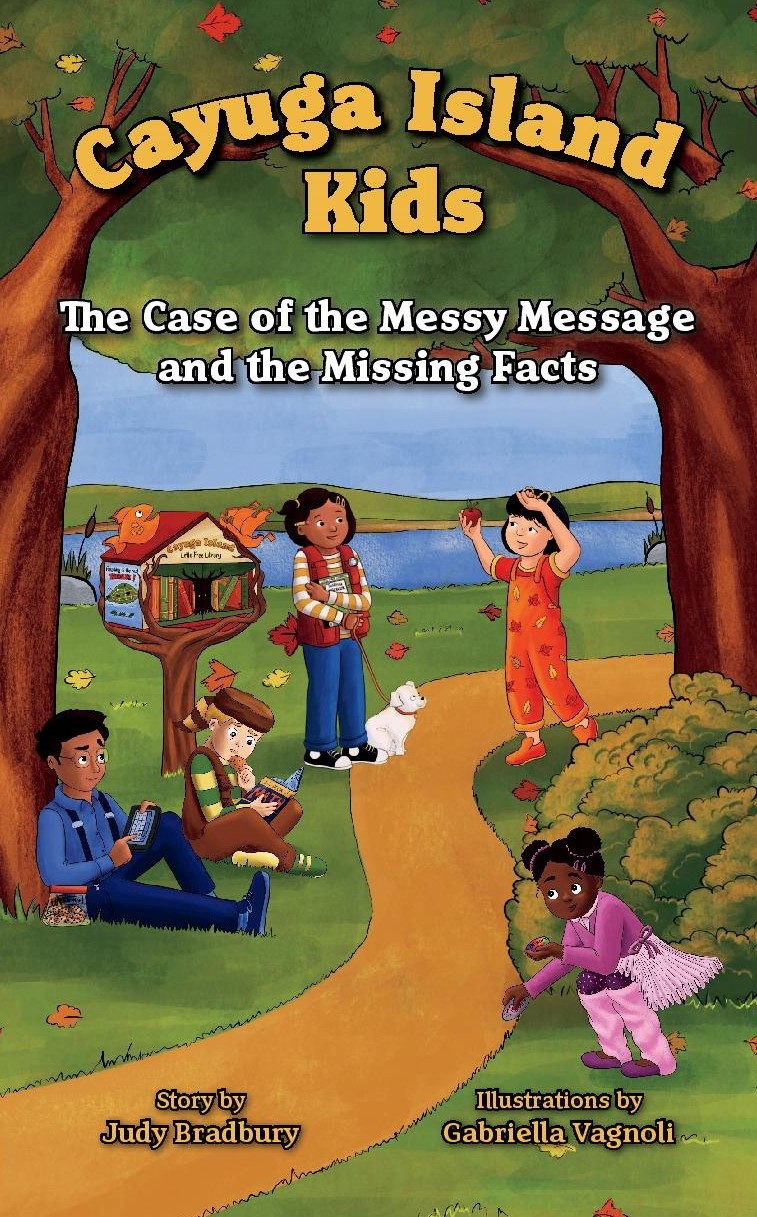
Book 3 of the Cayuga Island Kids chapter book series hits the shelves in May! In The Case of the Messy Message and the Missing Facts, Julian explores food science as he experiments with recipes for the perfect chocolate chip cookie. Being a cookie sampler takes Mac’s mind off his troubles with fractions. Yoko practices for the school play tryouts, and Maya helps Ms. Choi with the Make-and-Take-Club. Lacey, of course, is searching for the next mystery to solve.
And then two of Ms. Choi’s glitter pens go missing. The clues and evidence point to a suspect, but are the Cayuga Island Kids jumping to conclusions? When a classmate jumps to conclusions and shares false information about Julian’s cookies, the kids join forces to set the facts straight. And while researching explorers for a school project, the kids uncover misinformation that blurs the truth, and makes the reasons for being a fact detective crystal clear. Sorting through clues and evidence—just like research—means making sure you have all the facts, and not just a fraction of the truth.
In this latest adventure, the Cayuga Island Kids face misinformation, faulty assumptions, flour bugs, and fractions. They also sample a bunch of chocolate chip cookies.
Advance praise for The Case of the Messy Message and the Missing Facts:
“The Cayuga Island Kids deliver again! I love the newest title in this smart series for its cozy mystery, convivial characters, and warm sense of community. Bonus: It is chock full of fun facts (and even a recipe!) woven into a story centered on the importance of gathering all the facts before drawing conclusions, an insight young readers will naturally tuck into their own life kits. Outstanding!” ~ Leslie Connor, author of The Truth as Told by Mason Buttle, a 2018 National Book Award Finalist and Winner of ALA’s Schneider Family Award in 2019
“To solve a mystery surrounding missing gel pens, young readers engage with the concepts of misinformation, disinformation and jumping to conclusions. This is a delightful read for 7-10 year-olds, with age-appropriate word choice and just the right amount of description. The Cayuga Island Kids—and readers—learn that once information is out, it’s very difficult, if not impossible, to rein in. I recommend The Case of the Messy Message and the Missing Facts to young mystery enthusiasts who will learn about news literacy through the cast of diverse, well-developed characters.” ~ Pamela Brunskill, senior manager of education and content at the News Literacy Project and co-author of Information Literacy: Separating Fact from Fiction
View the book trailer.
Pre-order a copy of The Case of the Messy Message and the Missing Facts and be entered in a raffle to receive swag to go along with the book!
Find information on my upcoming events.
Red, White, and Whole by Rajani LaRocca was awarded a 2022 Newbery Honor. Find my interview with the author and resources for using this middle grade novel-in-verse with students here.
A complete listing of all the 2022 ALA Youth Media Awards
A list of poetry for young people publishing in 2022
Final Thought
“Each of us must confront our own fears, must come face to face with them. How we handle our fears will determine where we go with the rest of our lives. To experience adventure or to be limited by the fear of it.have come to believe, more than ever, that unfailing kindness and love and connection are essential elements for successful recovery. At least, I think that’s the best place to start–with an open, fragile, resilient heart. And never, ever give up hope.” ~ Judy Blume, Tiger Eyes

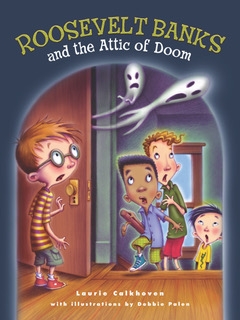
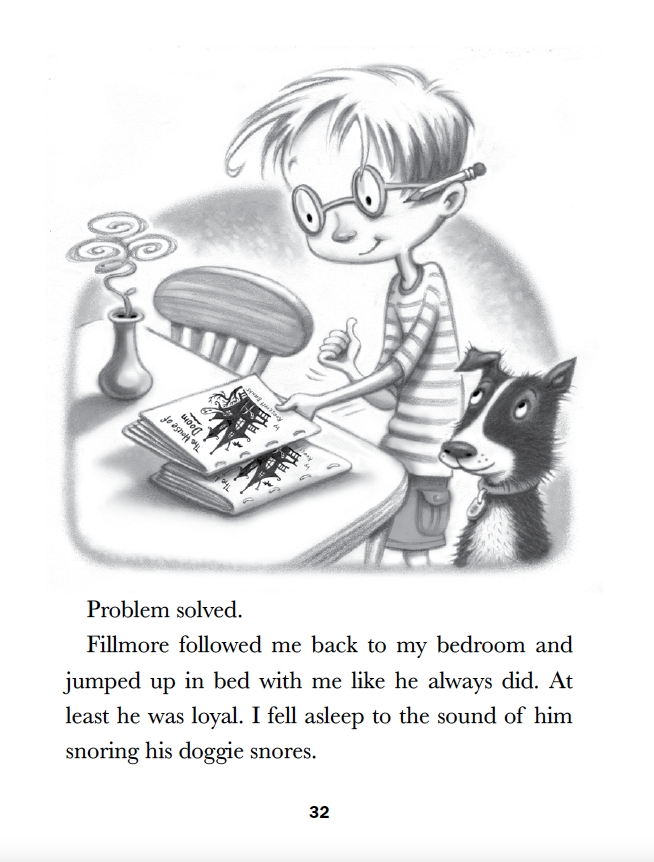
Looking forward to reading both Laurie’s new book (I enjoyed the first Roosevelt Banks book) and yours (the first two were so much fun). I enjoy how both series are about real kids having “little” adventures rather than being about a child saving the world. But there’s still lots of humor and insight. Hurray for both of you! (And, yes, in each case the illustrations seem the perfect choice.)
Thank you, Vivian, for your very kind and generous comments.